Submitted:
24 October 2023
Posted:
25 October 2023
You are already at the latest version
Abstract
Keywords:
1. Introduction
2. Materials and Methods
2.1. Experimental materials
2.2. Experimental methods
2.2.1. RNA extraction, library preparation, and Illumina sequencing
2.2.2. Data filtering and de novo assembly
2.2.3. DEGs screening and enrichment analysis
2.2.4. Quantitative real time-PCR validation
3. Results
3.1. Transcriptome sequencing analysis
3.2. Transcription splicing, comparison, and annotation
3.3. Statistics for DEGs
3.4. Enrichment analysis of DEGs
3.5. Seasonal changes in DEGs
3.6. Validation analysis using qRT-PCR
4. Discussion
5. Conclusions
Author Contributions
Funding
Institutional Review Board Statement
Data Availability Statement
Acknowledgments
Conflicts of Interest
References
- Arancibia, S. A.; Beltrán, C. J.; Aguirre, I. M.; Silva, P., Peralta; A. L.; Malinarich, F.; Hermoso, M. A. Toll-like receptors are key participants in innate immune responses. Biol. Res. 2007, 40(2), 97-112. [CrossRef]
- Austbø, L.; Aas, I. B.; König, M.; Weli, S. C.; Syed, M.; Falk, K.; Koppang, E. O. Transcriptional response of immune genes in gills and the interbranchial lymphoid tissue of Atlantic salmon challenged with infectious salmon anaemia virus. Dev. Comp. Immunol. 2014, 45(1), 107-114. [CrossRef]
- Buckley, B. A.; Gracey, A. Y.; Somero, G. N. The cellular response to heat stress in the goby Gillichthys mirabilis: a cDNA microarray and protein-level analysis. J. Exp. Biol. 2006, 209(14): 2660-2677. [CrossRef]
- Canesi, L.; Betti, M.; Ciacci, C.; Lorusso, L. C.; Pruzzo, C.; Gallo, G. Cell signalling in the immune response of mussel hemocytes. Invert. Surviv. J. 2006, 3(1), 40-49.
- Cao, W.; Wang, W.; Fan, S.; Li, J.; Li, Q.; Wu, S.; Wang, L.; Song, L. The receptor CgIL-17R1 expressed in granulocytes mediates the CgIL-17 induced haemocytes proliferation in Crassostrea gigas. Dev Comp Immunol. 2022, 131, 104376. [CrossRef]
- Frydman, J. (2001). Folding of newly translated proteins in vivo: the role of molecular chaperones. Annu. Rev. Biochem. 2001, 70, 603-647. [CrossRef]
- Fu, X.; Sun, Y.; Wang, J.; Xing, Q.; Zou, J.; Li, R.; Wang, Z.; Wang, S.; Hu, X.; Zhang, L.; Bao, Z. Sequencing-based gene network analysis provides a core set of gene resource for understanding thermal adaptation in Zhikong scallop Chlamys farreri. Mol. Ecol. Resour. 2014, 14(1), 184-198.
- Ge, X.; Zhao, J.; Liang, Z.; Chi, Q.; Mao, J.; Wang, X.; et al. Comparative analysis of Neptunea cumingii growth, related digestive and immune enzyme indicators, and liver transcriptome under different feeding conditions. Front. Mar. Sci. 2022, 9, 1013180. [CrossRef]
- Guo, D.; Liu, X. Z.; Wang, A. Y.; Wang, B.; Li, Y. P.; Dong, J. Stock distribution of whelk Neptunea cumingii Crosse in Liaodong Bay. Fish. Sci. 2015, 34, 718–721.
- Hao, S.; Zhang M. Effects of different cold stress on antioxidant enzyme activity and lipid peroxidation of Sinonovacula constrictus. J. Dalian Univ. 2020, 35(4): 584-590.
- Hao, Z. L.; Wang, Y.; Yu, Y. Y.; Zhan, Y. Y.; Tian, Y.; Wang, L.; et al. Analysis and evaluation of nutritive composition in the muscle of Neptunea arthritica cumingii Crosse (Gastropoda: Buccinidae). J. Dalian Univ. 2016, 37, 66–70.
- Havas, M.; Rosseland, B. O. Response of zooplankton, benthos, and fish to acidification: an overview. Water Air Soil Pollut. 1995, 85, 51-62. [CrossRef]
- Hu, Z.; Feng, J.; Song, H.; Zhou, C.; Yu, Z. L.; Yang, M. J.; et al. Mechanisms of heat and hypoxia defense in hard clam: insights from transcriptome analysis. Aquaculture 2022, 549, 737792. [CrossRef]
- Huang, X. D.; Zhang, H.; He, M. X. Comparative and evolutionary analysis of the interleukin 17 gene family in invertebrates. PLoS One 2015, 10(7), e0132802. [CrossRef]
- Jiang, W.; Fang, J.; Li, J.; et al. Effects of temperature stress on physiological and biochemical activities of Haliotis discus hannai Ino. J. Fish. Sci. China. 2017, 24(2): 220-230.
- Jiang, W.; Lin, F.; Fang, J.; Gao, Y.; Du, M.; Fang, J.; et al. Transcriptome analysis of the Yesso scallop, Patinopecten yessoensis gills in response to water temperature fluctuations. Fish Shellfish Immunol. 2018, 80, 133-140. [CrossRef]
- Jing, H.; Zhou, L.; Gao, Y.; Liu, Z.; Wu, B.; Sun, X.; et al. Transcriptomics and metabolomics reveal the molecular and metabolic adaptation to heat stress in Manila clam Ruditapes philippinarum. Front. Mar. Sci. 2023,10, 1204598. [CrossRef]
- Johnston, I. A.; Frearson, N.; Goldspink, G. The effects of environmental temperature on the properties of myofibrillar adenosine triphosphatase from various species of fish. Biochem J. 1973, 133(4), 735-738. [CrossRef]
- Kim, M.; Ahn, I.Y.; Cheon, J.; Park H. Molecular cloning and thermal stress-induced expression of a pi-class glutathione S-transferase (GST) in the Antarctic bivalve Laternula elliptica. Comp. Biochem. Physiol. A. Mol. Integr. Physiol. 2009, 152(2): 207-213. [CrossRef]
- Li, B.; Dewey, C. N. RSEM: accurate transcript quantification from RNA-Seq data with or without a reference genome. BMC bioinformatics 2011,12, 1-16. [CrossRef]
- Li, H.; Zhong, R.; Fang, Y.; Yang, L. Research progress of oxidative stress and immunity in animals. Chin. J. Anim. Nutr. 2014, 26(11), 3217-3221.
- Li, J.; Zhang, Y.; Zhang, Y.; Xiang, Z.; Tong, Y.; Qu, F.; Yu, Z. Genomic characterization and expression analysis of five novel IL-17 genes in the Pacific oyster, Crassostrea gigas. Fish Shellfish Immunol. 2014, 40(2), 455-465. [CrossRef]
- Li, Y. W.; Luo, X. C.; Dan, X. M.; Huang, X. Z.; Qiao, W.; Zhong, Z. P.; Li, A. X. Orange-spotted grouper (Epinephelus coioides) TLR2, MyD88 and IL-1β involved in anti-Cryptocaryon irritans response. Fish Shellfish Immunol. 2011, 30(6), 1230-1240.
- Lin, Y.; Xiao, Q.; Hao, Q.; Qian, Z.; Li, X.; Li, P.; et al. Genome-wide identification and functional analysis of the glutathione S-transferase (GST) family in Pomacea canaliculata. Int J Biol Macromol. 2021, 193, 2062-2069. [CrossRef]
- Liu, P.; Lu, Z.; Liu, L.; Li, R.; Liang, Z.; Shen, M.; et al. NOD-like receptor signaling in inflammation-associated cancers: from functions to targeted therapies. Phytomedicine 2019,64, 152925. [CrossRef]
- Livak, K. J.; Schmittgen, T. D. Analysis of relative gene expression data using real-time quantitative PCR and the 2− ΔΔCT method. Methods (2001), 25(4), 402-408.
- Malek, R. L.; Sajadi, H.; Abraham, J.; Grundy, M. A.; Gerhard, G. S. The effects of temperature reduction on gene expression and oxidative stress in skeletal muscle from adult zebrafish. Comp. Biochem. Physiol. C. Toxicol. Pharmacol. 2004, 138(3), 363-373. [CrossRef]
- Mao, J.; Huang, X.; Sun, H.; Jin, X.; Guan, W.; Xie, J.; et al. Transcriptome analysis provides insight into adaptive mechanisms of scallops under environmental stress. Front. Mar. Sci. 2022, 9, 971796. [CrossRef]
- Mattson, M. P.; Meffert, M. K. Roles for NF-κB in nerve cell survival, plasticity, and disease. Cell. Death. Differ. 2006, 13(5), 852-860.
- Menike, U.; Lee, Y.; Oh, C.; Wickramaarachchi, W. D. N.; Premachandra, H. K. A.; Park, S. C.; et al. Oligo-microarray analysis and identification of stress-immune response genes from manila clam (Ruditapes philippinarum) exposure to heat and cold stresses. Mol. Biol. Rep. 2014, 41, 6457-6473. [CrossRef]
- Qi, Z. Taxonomic studies of benthic invertebrates. Mar. Sci. 1979, (S1), 66-69.
- Ren, J.; Long, Y.; Liu, R.; Song, G.; Li, Q.; Cui, Z. Characterization of biological pathways regulating acute cold resistance of zebrafish. Int. J. Mol. Sci. 2021, 22(6), 3028. [CrossRef]
- Roberts, R. J.; Agius, C.; Saliba, C.; Bossier, P.; Sung, Y. Y. Heat shock proteins (chaperones) in fish and shellfish and their potential role in relation to fish health: a review. J. Fish. Dis. 2010, 33(10), 789-801. [CrossRef]
- Saco, A.; Rey-Campos, M.; Rosani, U.; Novoa, B.; Figueras, A. The evolution and diversity of interleukin-17 highlight an expansion in marine invertebrates and its conserved role in mucosal immunity. Front. Immunol. 2021, 12, 692997. [CrossRef]
- Sørensen, J. G.; Kristensen, T. N.; Loeschcke, V. The evolutionary and ecological role of heat shock proteins. Ecol. Lett. 2003, 6(11), 1025-1037. [CrossRef]
- Sun, J.; Song, L. Research progress of inflammation and its pathogenesis in shellfish. J. Dalian Univ. 2023, 38 (03), 369-379.
- Sun, J.; Li, Y.; Li, M.; Liu, Y.; Qu, C.; Wang, L.; Song, L. A novel JNK is involved in immune response by regulating IL expression in oyster Crassostrea gigas. Fish Shellfish Immunol. 2018, 79, 93-101. [CrossRef]
- Sun, J.; Wang, L.; Wu, Z.; Han, S.; Wang, L.; Li, M.; et al. P38 is involved in immune response by regulating inflammatory cytokine expressions in the Pacific oyster Crassostrea gigas. Dev. Comp. Immunol. 2019, 91, 108-114. [CrossRef]
- Takeuchi, O.; Akira, S. Pattern recognition receptors and inflammation. Cell 2010, 140(6), 805-820. [CrossRef]
- Tan, B.; Zhang, D.; Tian, Y.; Mao, J.; Wang, X.; Wang, L.; et al. Genetic structure and local adaptation of Neptunea cumingii crosse populations in China based on GBS technology. Front. Ecol. Evol. 2023, 11, 1154781. [CrossRef]
- Tan, K.; Zhang, B.; Ma, H.; Li, S.; Zheng, H. Oxidative stress responses of golden and brown noble scallops Chlamys nobilis to acute cold stress. Fish Shellfish Immunol. 2019, 95, 349-356. [CrossRef]
- Tang, T.; Li, W.; Wang, X.; Wu, Y.; Liu, F. A house fly TNF ortholog Eiger regulates immune defense via cooperating with Toll and Imd pathways. Dev. Comp. Immunol. 2019, 90, 21-28. [CrossRef]
- Tanji, T.; Ip, Y. T. Regulators of the Toll and Imd pathways in the Drosophila innate immune response. Trends Immunol. 2005, 26(4), 193-198. [CrossRef]
- Tomanek, L. Proteomics to study adaptations in marine organisms to environmental stress. J. Proteomics. 2014, 105, 92-106. [CrossRef]
- van Noort, J. M.; Bsibsi, M.; Nacken, P.; Gerritsen, W. H.; Amor, S. The link between small heat shock proteins and the immune system. Int. J. Biochem. Cell. Biol. 2012, 44(10), 1670-1679. [CrossRef]
- Vosloo, D.; Vosloo, A. Response of cold-acclimated, farmed South African abalone (Haliotis midae) to short-term and long-term changes in temperature. J. Therm. Biol. 2010, 35(7), 317-323. [CrossRef]
- Wang, J.Y.; Zhu, S.G.; Xu, C.F. Biochemistry. 3rd ed. Beijing: Higher Education Press, 2002; 114-146.
- Wang, J.; Ren, R. M.; Yao, C. L. Oxidative stress responses of Mytilus galloprovincialis to acute cold and heat during air exposure. J. Molluscan. Stud. 2018, 84(3), 285-292. [CrossRef]
- Wang, L.; Wang, W. N.; Liu, Y.; Cai, D. X.; Li, J. Z.; Wang, A. L. Two types of ATPases from the Pacific white shrimp, Litopenaeus vannamei in response to environmental stress. Mol. Biol. Rep. 2012, 39, 6427-6438. [CrossRef]
- Wang, Q.; Liu, Y.; Zheng, Z.; Deng, Y.; Jiao, Y.; Du, X. Adaptive response of pearl oyster Pinctada fucata martensii to low water temperature stress. Fish Shellfish Immunol. 2018, 78, 310-315. [CrossRef]
- Wang, X.; Cao, S.; Liu, G.; Wang, Y.; Zou, J. Effects of temperature on water-free preservation and antioxidant enzyme activity of Crassadoma gigantea. Mar. Sci. Bull. 2018, 20(01),1-20.
- Wang, Y.; Han, Y.; Wang, Y.; Lv, M.; Li, Y.; Niu, D. Expression of p38MAPK and its regulation of apoptosis under high temperature stress in the razor clam Sinonovacula constricta. Fish Shellfish Immunol. 2022, 122, 288-297. [CrossRef]
- Wang, Z.; Ren, X.; Gao, B.; Liu, P.; Li, J.; Wang, L. Changes in oxidative phosphorylation metabolism of Portunus trituberculatus in family inbreeding. J. Fish. Sci. China. 2018, 25(03), 520-535.
- Wu, S. Z.; Huang, X. D.; Li, Q.; He, M. X. Interleukin-17 in pearl oyster (Pinctada fucata): molecular cloning and functional characterization. Fish Shellfish Immunol. 2013, 34(5), 1050-1056. [CrossRef]
- Xin, L.; Liu, C.; Zhang, H.; Qiu, L.; Wang, L.; Song, L. The characterization of an interleukin-12 p35 homolog involved in the immune modulation of oyster Crassostrea gigas. Dev. Comp. Immunol. 2021, 123, 104145. [CrossRef]
- Xu, Y.; Wu, W.; Jiang, W.; Ding, Z. Effects of temperature on immune system of shellfish and its mechanisms. Fish. Sci. 2012, 31(03),176-180.
- Xue, S.; Wang, J.; Li, J.; Ding, J.; Li, Y.; Xu, H.; et al. Effects of temperature on energy metabolism and antioxidant enzyme activities of Scapharca broughtonii. J. Fish. China. 2019, 43(3), 573-583.
- Yang, Y.; Yu, H.; Li, H.; Wang, A.; Yu, H. Y. Effect of high temperature on immune response of grass carp (Ctenopharyngodon idellus) by transcriptome analysis. Fish Shellfish Immunol. 2016, 58, 89-95. [CrossRef]
- Yu, Y. Y.; Li, J.; Wu, W.; Hao, Z. L. Research progress on the reproductive biology and artificial breeding technology of the Neptunea cumingii. Hebei Fisheries. 2019, (04), 54–56.
- Zhang, Q. H.; Wang, S. J.; Tian, Y.; Wang, L.; Mao, J. X.; Wang, X. B.; et al. Effects of dissolved oxygen concentration on behavior, antioxidant enzyme activities and tissue structure of whelk Neptunea cumingii Crosse. J. Dalian Ocean Univ. 2022, 37, 643–649.
- Zhang, S. Y.; Wang, S. J.; Yang, J. C.; Zhu, J. Y.; Tian, Y.; Wang, L.; et al. Effects of salinity on behavior, activities of antioxidant enzymes and tissue structure of gill and kidney of whelk Neptunea cumingii Crosse. Mar. Sci. 2022, 46, 129–139.
- Zhu, Q.; Zhang, L.; Li, L.; Que, H.; Zhang, G. Expression characterization of stress genes under high and low temperature stresses in the Pacific oyster, Crassostrea gigas. 2016, Mar. Biotechnol. 18(2), 176-188. [CrossRef]
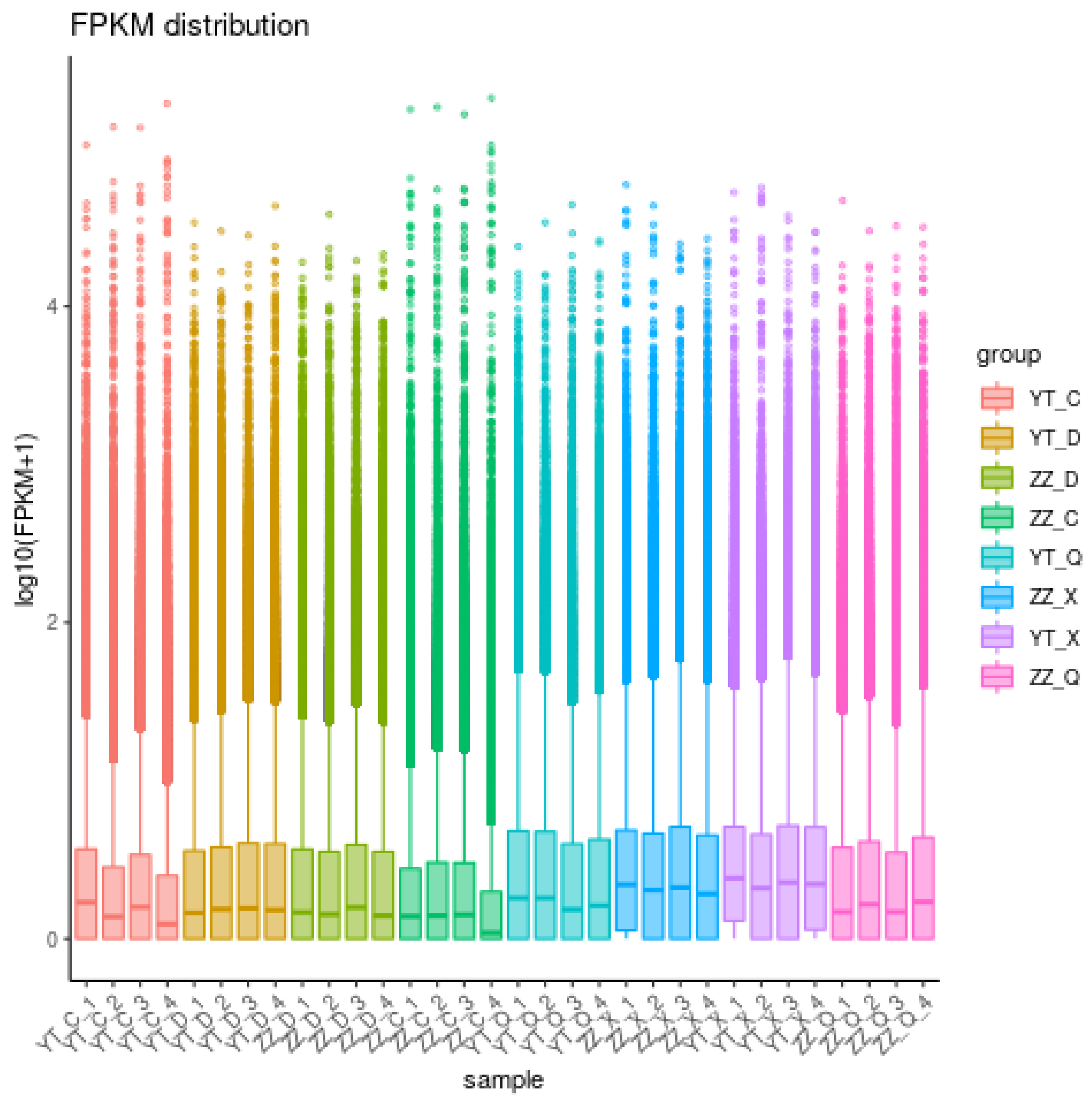
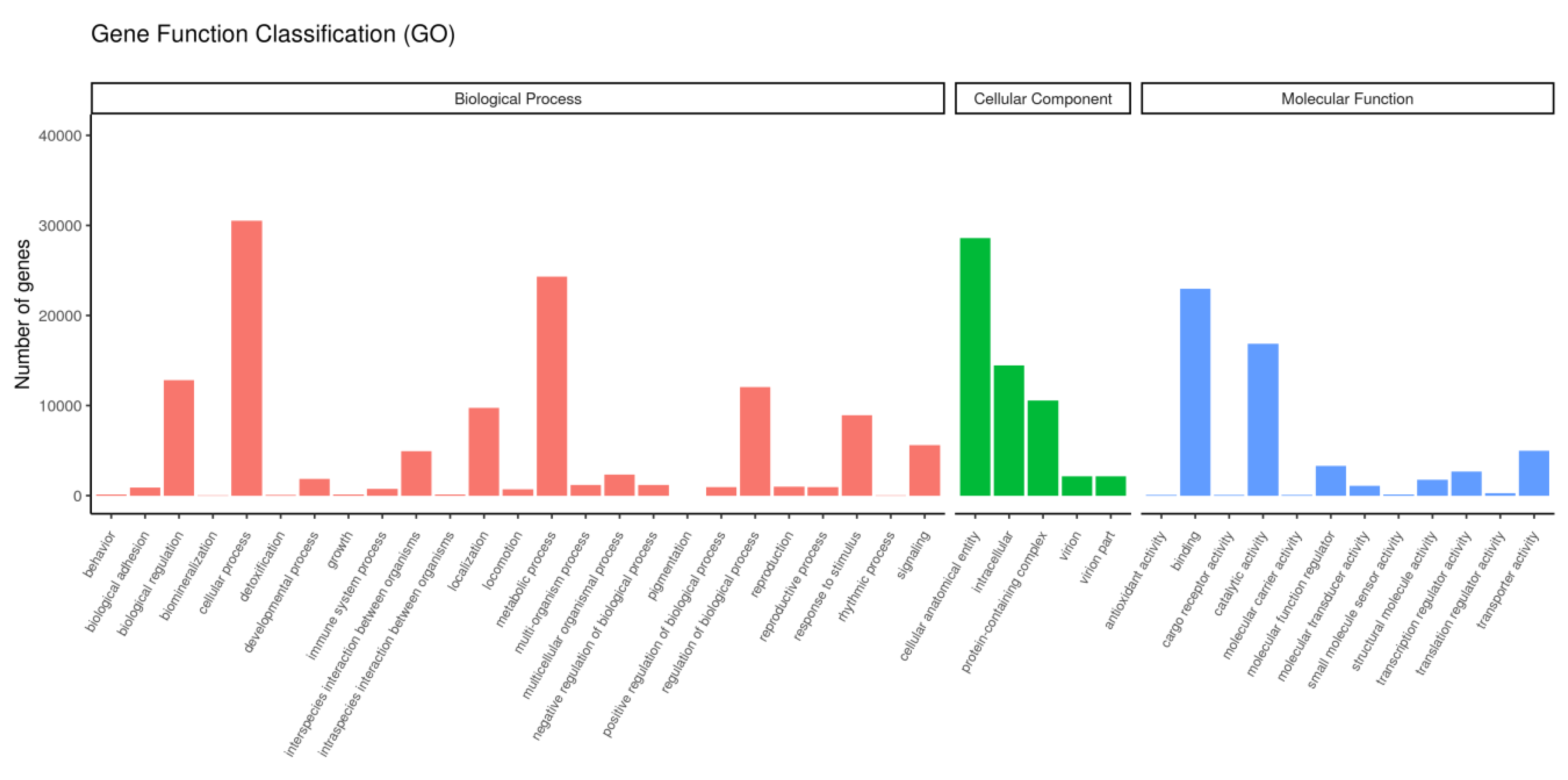
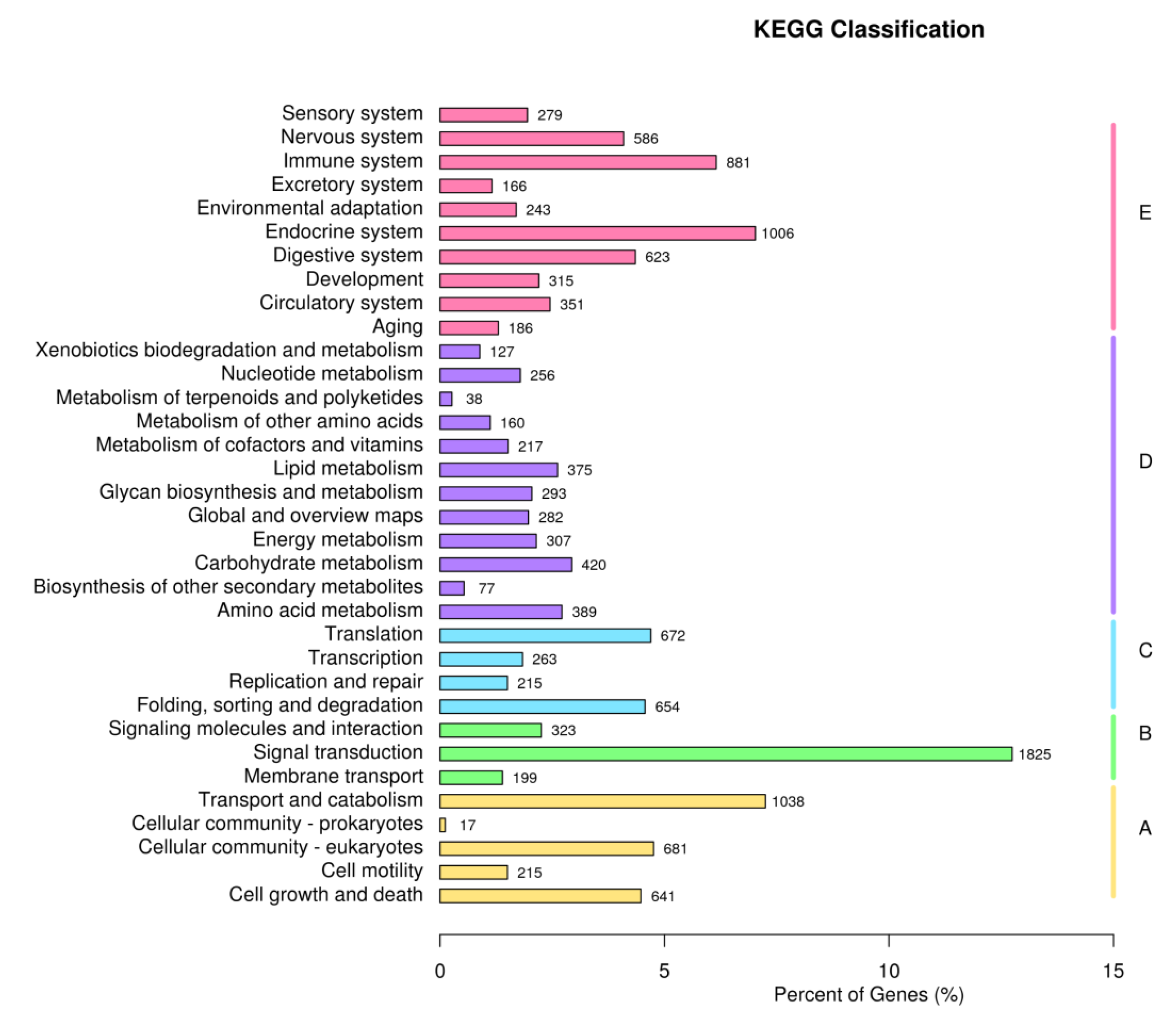
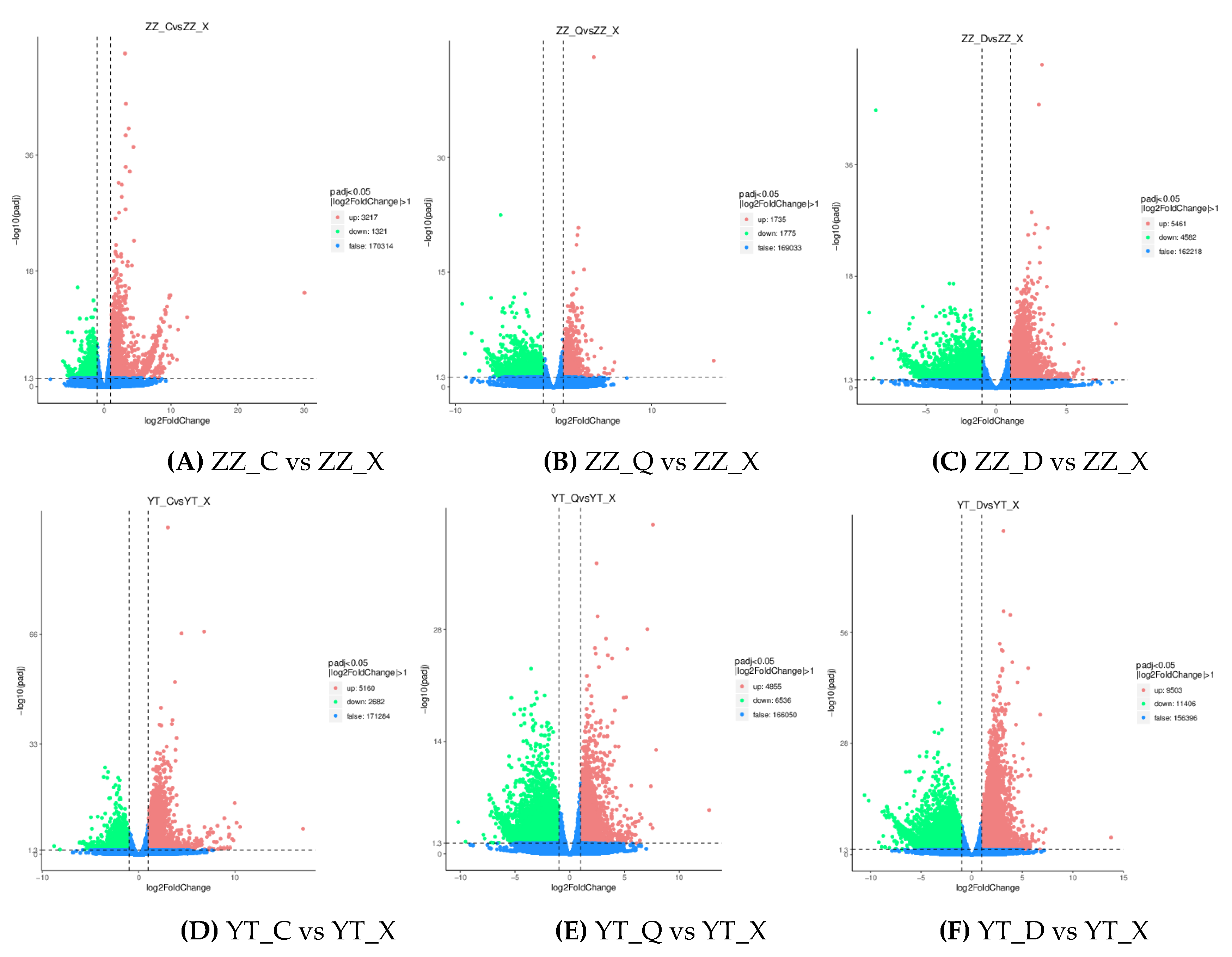
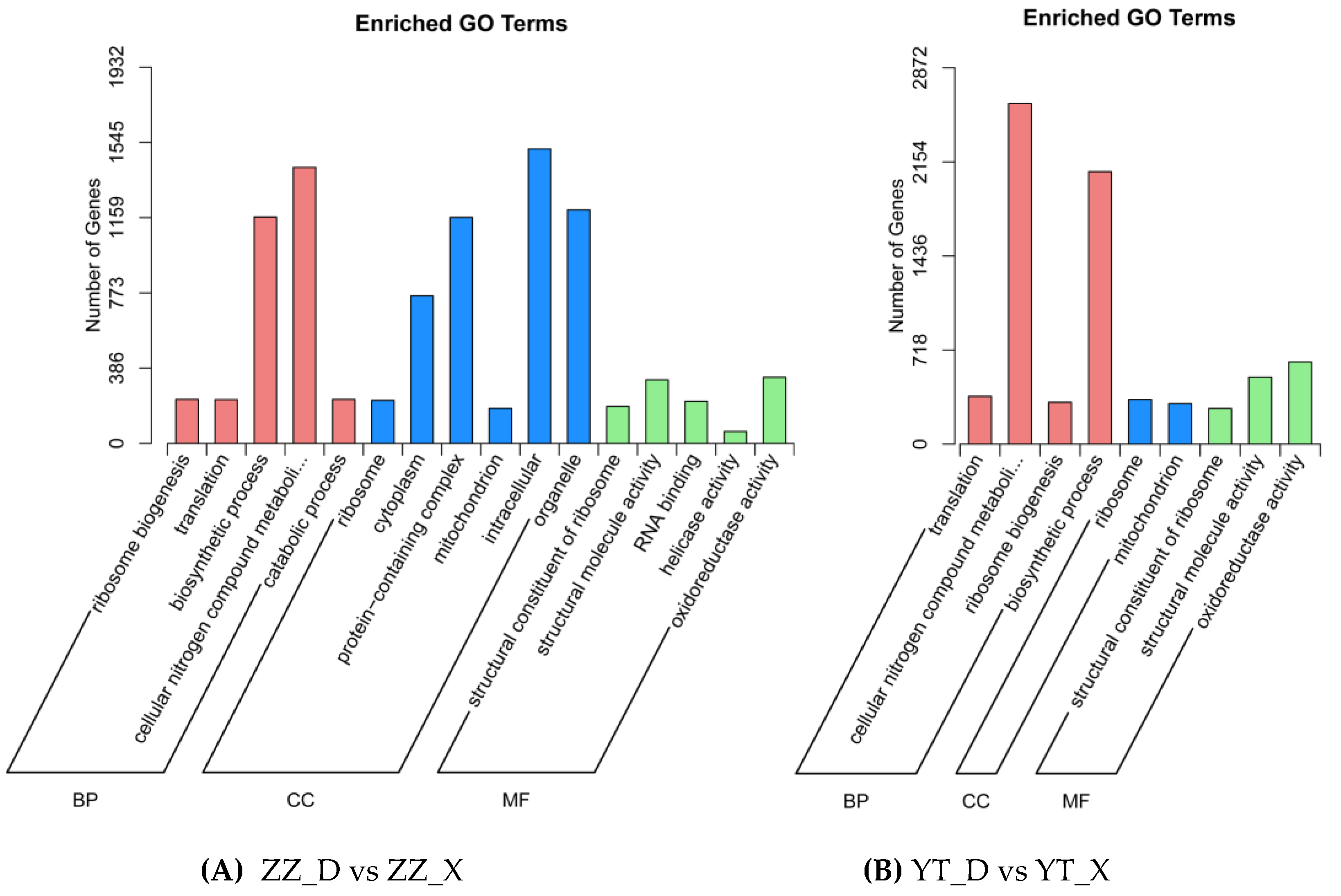
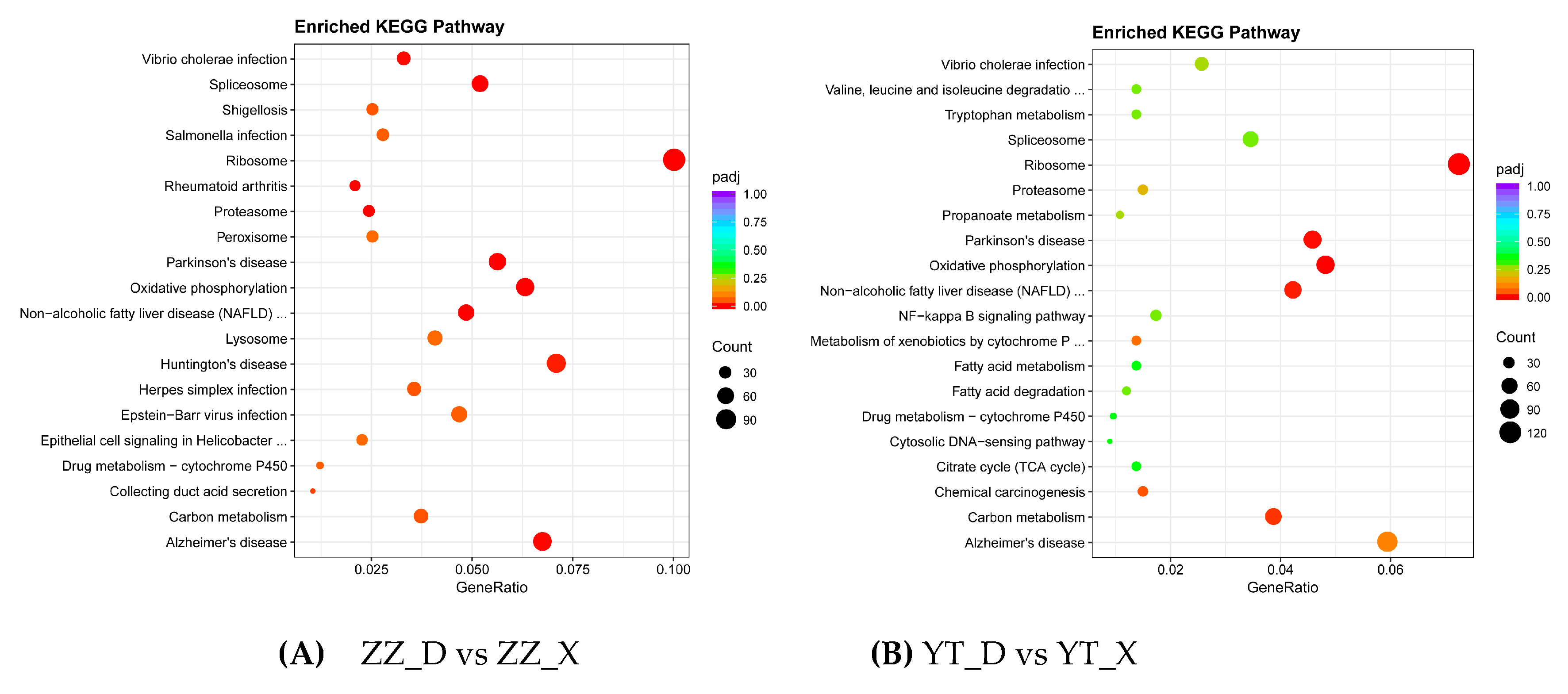
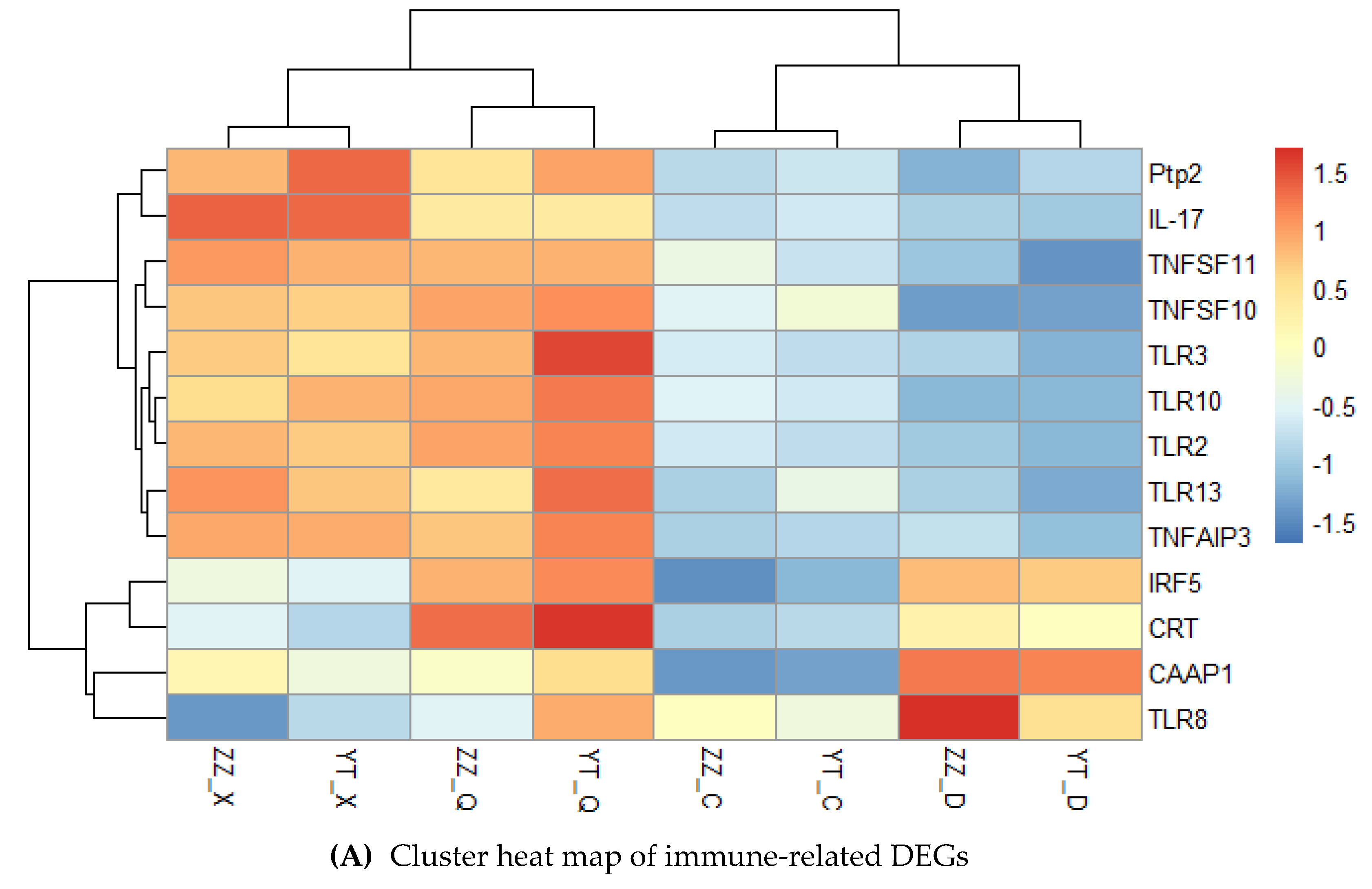
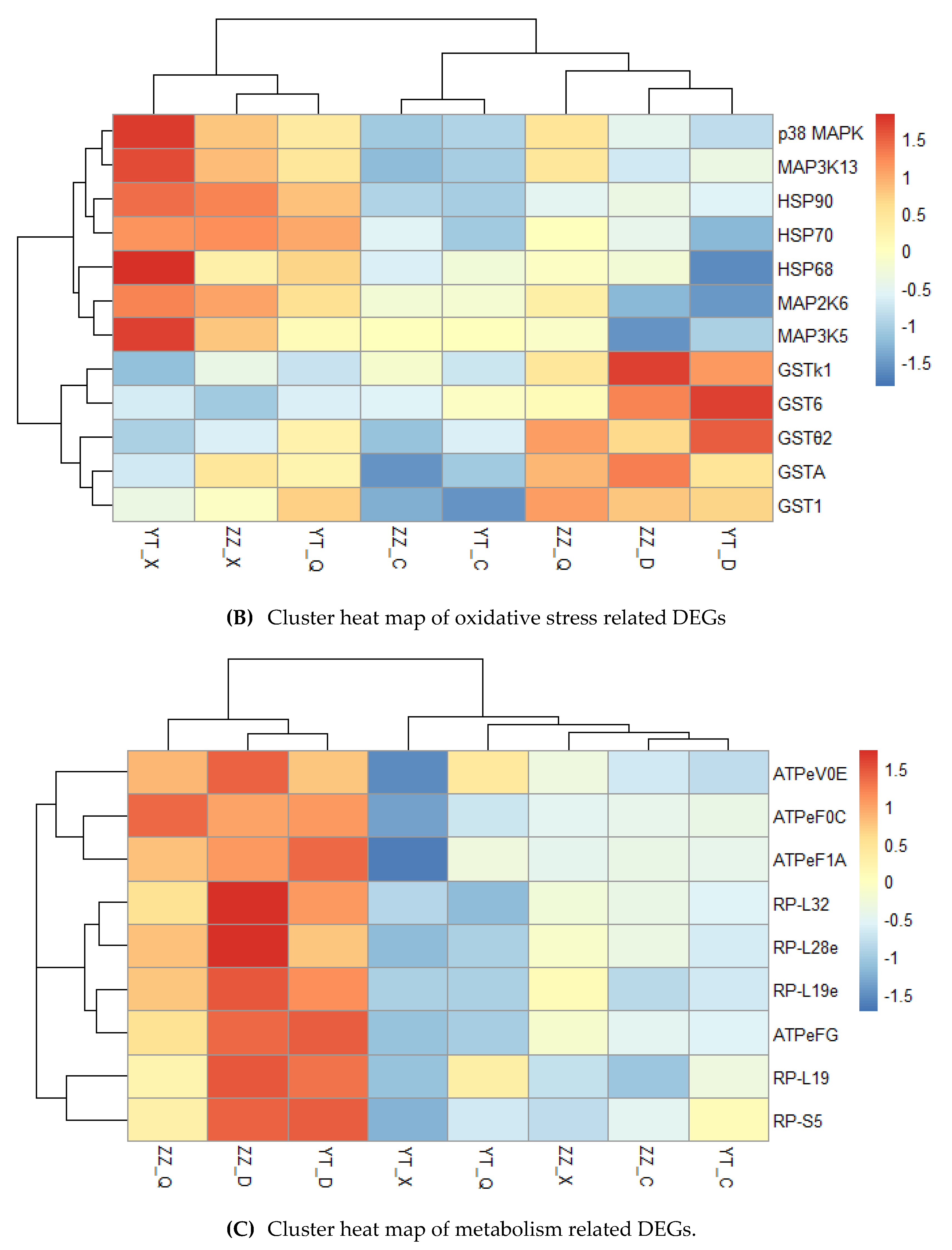
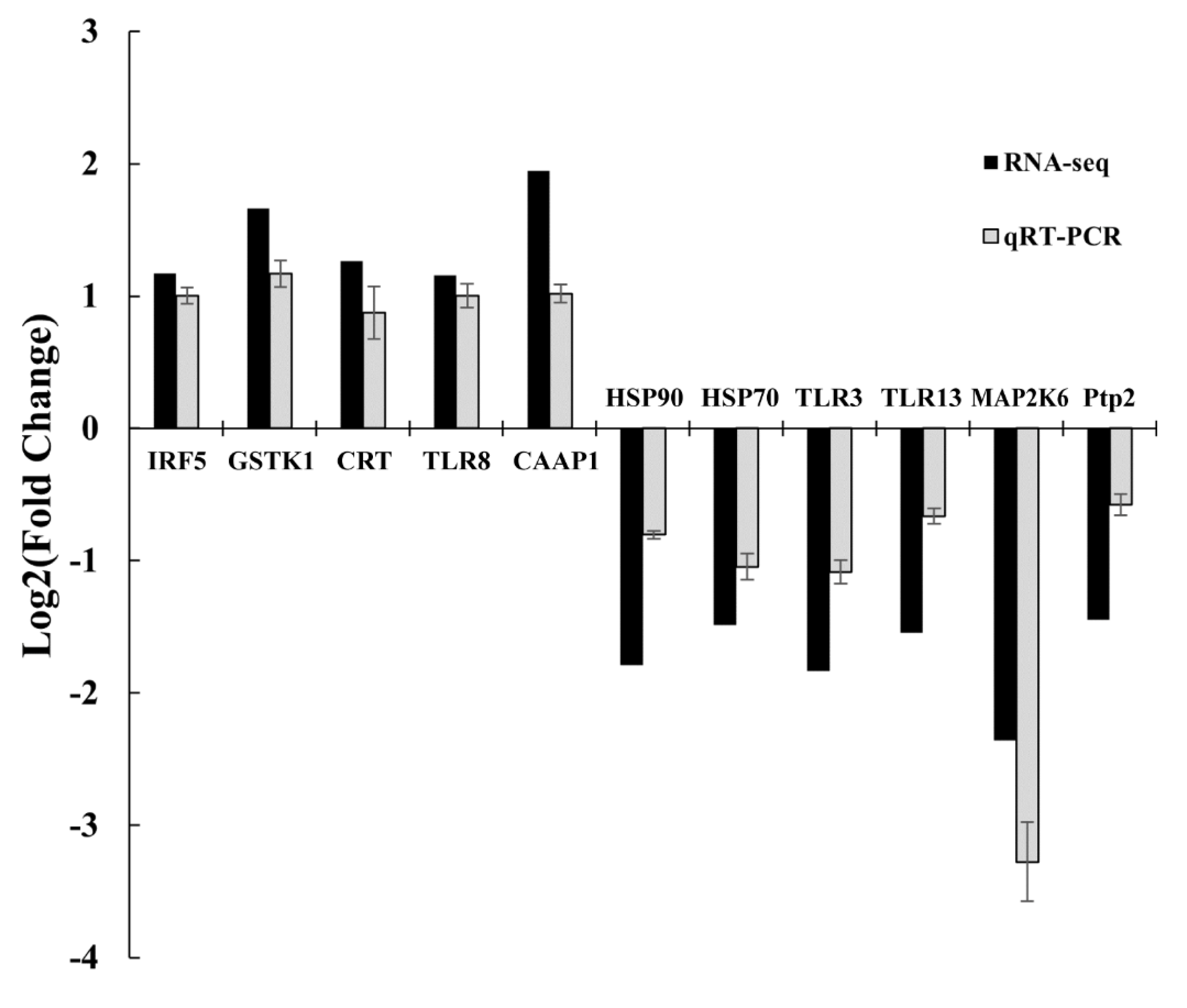
| Gene | Forword primer(5'-3') | Reverse primer (5'-3') |
|---|---|---|
| 18S-F | TCTTGATTCGGTGGGTGGTG | CCCGGACATCTAAGGGCATC |
| CAAP1-F | GTATTCGCTGATCCCCAGCA | GTAACTCACGCCGCAGAAAC |
| TLR8-F | CTCATCCGCAGGGAGTTGTT | GACCCGCACACAGTTCTACA |
| TLR13-F | GACCACGGAGGCACACTAAA | CCGGAACCACACAGACAAGA |
| TLR3-F | CAACCTGACCTCGCTGTCTT | TCTTTCAGCCGGTTCAGTCC |
| HSP70-F | AGGAGGGTTCAAGAGGGTGT | AATCTCTGCGGTGTGCTTCA |
| HSP90-F | CCCACCCCGAACTTATTGCT | TGTTCCAGGTTTCCACGCTT |
| CRT-F | GAAAGCCGCGCTGACTAAAG | AAAGCCTCTCTTGTTGCGGA |
| Ptp2-F | GTGCAAAGTTGTGCAGGAGG | AAGATGAGGACGAGGACGGA |
| GSTK1-F | TTGCACACGTCAACGAACAC | ATGGCTGTTCAGGATTGGGG |
| IRF5-F | TTTCTCCGCATCAAGCCACT | GCCATTGCACCAAGGACAAG |
| MAP2K6-F | AGCAGGGAAAAGGCAGACAA | AGCTGCCGTGTTATGTGTGA |
| Sample | raw_bases | clean_bases | Q20(%) | Q30(%) | GC-Content(%) |
|---|---|---|---|---|---|
| ZZ_C_1 | 7.1G | 6.83G | 97.23 | 92.99 | 39.87 |
| ZZ_C_2 | 6.88G | 6.65G | 97.46 | 93.14 | 40.33 |
| ZZ_C_3 | 6.6G | 6.4G | 97.2 | 92.63 | 40.93 |
| ZZ_C_4 | 6.41G | 6.23G | 97.55 | 93.41 | 37.47 |
| YT_C_1 | 6.79G | 6.49G | 96.86 | 92.54 | 43.71 |
| YT_C_2 | 6.96G | 6.58G | 96.51 | 91.48 | 41.71 |
| YT_C_3 | 7.2G | 6.91G | 97.08 | 92.88 | 41.59 |
| YT_C_4 | 6.64G | 6.45G | 97.5 | 93.08 | 38.17 |
| ZZ_X_1 | 7.08G | 6.61G | 96.67 | 92.23 | 44.03 |
| ZZ_X_2 | 7.16G | 6.67G | 96.46 | 91.79 | 43.81 |
| ZZ_X_3 | 6.3G | 5.78G | 96.72 | 92.51 | 44.97 |
| ZZ_X_4 | 6.29G | 5.75G | 96.83 | 92.61 | 45.42 |
| YT_X_1 | 6.88G | 6.32G | 96.37 | 91.7 | 44.52 |
| YT_X_2 | 7.01G | 6.54G | 96.86 | 92.58 | 44.46 |
| YT_X_3 | 6.37G | 5.89G | 96.64 | 92.15 | 44.73 |
| YT_X_4 | 6.96G | 6.29G | 96.61 | 92.11 | 45.11 |
| ZZ_Q_1 | 6.95G | 6.55G | 96.91 | 92.61 | 44.64 |
| ZZ_Q_2 | 6.99G | 6.6G | 96.98 | 92.59 | 45.15 |
| ZZ_Q_3 | 6.83G | 6.42G | 97.02 | 92.68 | 44.86 |
| ZZ_Q_4 | 6.92G | 6.44G | 96.75 | 92.29 | 45.8 |
| YT_Q_1 | 6.83G | 6.35G | 96.69 | 92.31 | 45.61 |
| YT_Q_2 | 6.95G | 6.41G | 96.59 | 92.09 | 45.95 |
| YT_Q_3 | 7.02G | 6.56G | 96.77 | 92.37 | 44.19 |
| YT_Q_4 | 6.73G | 6.15G | 96.51 | 91.96 | 45.43 |
| ZZ_D_1 | 7.13G | 6.74G | 96.04 | 90.74 | 44.98 |
| ZZ_D_2 | 6.79G | 6.39G | 95.64 | 90.12 | 44.21 |
| ZZ_D_3 | 6.97G | 6.55G | 95.94 | 90.6 | 44.69 |
| ZZ_D_4 | 6.81G | 6.36G | 95.92 | 90.52 | 44.42 |
| YT_D_1 | 6.47G | 6.08G | 95.64 | 90.11 | 44.56 |
| YT_D_2 | 7.43G | 6.95G | 95.99 | 90.51 | 44.89 |
| YT_D_3 | 7.1G | 6.67G | 96.15 | 90.97 | 44.29 |
| YT_D_4 | 7.16G | 6.67G | 96.01 | 90.62 | 42.31 |
| Total | 300-500bp | 500-1kbp | 1k-2kbp | >2kbp | total nucleotides | max length | min length | N50 | N90 | |
| Transcript | 398505 | 156348 | 130839 | 71522 | 39796 | 383685494 | 30252 | 301 | 1335 | 420 |
| Unigene | 187640 | 80055 | 62261 | 30404 | 14920 | 165201498 | 30252 | 301 | 1147 | 399 |
| Number of Unigenes | Percentage (%) | |
| NR | 38761 | 20.65 |
| NT | 14670 | 7.81 |
| KO | 12238 | 6.52 |
| SwissProt | 19358 | 10.31 |
| PFAM | 51868 | 27.64 |
| GO | 51864 | 27.64 |
| KOG | 9929 | 5.29 |
| Annotated in all Databases | 3842 | 2.04 |
| Annotated in at least one Database | 73085 | 38.94 |
| Total Unigenes | 187640 | 100 |
Disclaimer/Publisher’s Note: The statements, opinions and data contained in all publications are solely those of the individual author(s) and contributor(s) and not of MDPI and/or the editor(s). MDPI and/or the editor(s) disclaim responsibility for any injury to people or property resulting from any ideas, methods, instructions or products referred to in the content. |
© 2024 by the authors. Licensee MDPI, Basel, Switzerland. This article is an open access article distributed under the terms and conditions of the Creative Commons Attribution (CC BY) license (https://creativecommons.org/licenses/by/4.0/).





